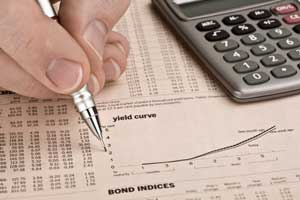Is the Yield Curve Signaling a Recession?

The yield curve plots rates on similar assets with different maturities, such as the 10-year U.S. Treasury note and the three-month U.S. Treasury bill. Typically, the difference between the rates (also called the term spread) is positive, meaning longer-maturity assets have a higher return than shorter-maturity assets. One reason for the positive spread is a liquidity premium. Securities with longer maturities are less readily able to be traded in for cash. The liquidity premium lowers the price on these bonds, which increases the yield (or return).
Yield curve inversions occur when the rates on short-term assets rise above long-term asset rates, leading to a negative yield spread. Assuming the liquidity premium has not changed, there are two primary reasons the spread could become negative:
- Increased risk
- Lower expectations about future outcomes, such as a recession
The risk premium of an asset is the premium associated with the difference in the likelihood of default of that asset over a risk-free asset. U.S. Treasuries are generally considered risk free. Thus, economists have previously linked inversions in the yield curve to recessions. For example, academic scholars,1 Federal Reserve economists2 and bloggers3 watch yield spreads closely, especially when the media is speculating about imminent recession.
The relationship between the yield spread and recessions has been borne out historically. The figure below shows the weekly yield spread (10-year Treasuries minus three-month Treasuries) from Dec. 1, 1981, to Feb. 1, 2016, with recessions, as defined by the National Bureau of Economic Research, shaded in gray.
Notice, in particular, that the yield spread turned negative before the beginning of the past three recessions. Declines in the yield spread are argued to signal economic slowdowns, but not all declines are associated with recessions. However, every case of a negative yield spread in the past 30 or so years has been followed by a recession within the next 12 months.
Numerous economists have tested the power of the yield spread in predicting recessions. In general, they find that the yield spread dominates other predictors at forecasting recessions. Estrella and Mishkin, for example, find that the yield curve beat other leading indicators for the 1990 recession.4 The figure demonstrates that a similar result would likely hold for the past two recessions.
Finally, notice that the current value of the yield spread is not negative. (In fact, it is strongly positive.) If the yield spread has truly become a harbinger of oncoming recession, rates would have to shift substantially prior to the onset of a recession.5
Notes and References
1 For example, see Estrella, Arturo; and Hardouvelis, Gikas. “The Term Structure as a Predictor of Real Economic Activity,” Journal of Finance, 1991, Vol. 46, Issue 2.
2 For example, see Estrella, Arturo; and Mishkin, Frederic S. “The Yield Curve as a Predictor of U.S. Recessions,” Federal Reserve Bank of New York Current Issues in Economics and Finance, June 1996, Vol. 2, Issue 7.
3 For example, see “Spreads and Recession Watch,” Econbrowser, Jan. 13, 2016.
4 Estrella, Arturo; and Mishkin, Frederic S. “The Yield Curve as a Predictor of U.S. Recessions,” Federal Reserve Bank of New York Current Issues in Economics and Finance, June 1996, Vol. 2, Issue 7.
5 One counterargument is that the short rate is historically low and that long rates cannot fall enough to produce a negative yield spread.
Additional Resources
- On the Economy: Better Measure of Output: GDP or GDI?
- On the Economy: Will Real Yields Decline Further if Inflation Rises?
- On the Economy: Is the U.S. Due for Another Recession?
Citation
Michael T. Owyang and Hannah Shell, ldquoIs the Yield Curve Signaling a Recession?,rdquo St. Louis Fed On the Economy, March 24, 2016.
This blog offers commentary, analysis and data from our economists and experts. Views expressed are not necessarily those of the St. Louis Fed or Federal Reserve System.
Email Us
All other blog-related questions



